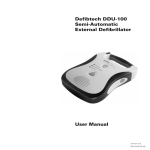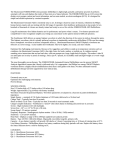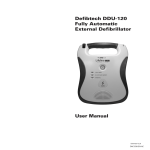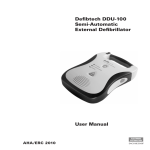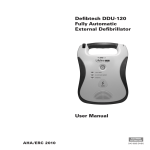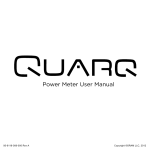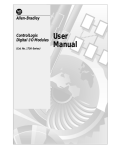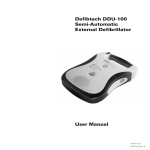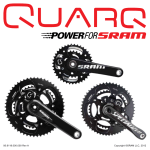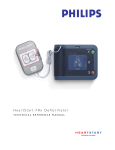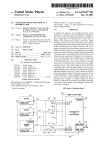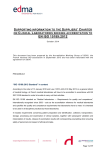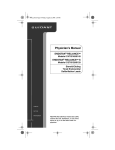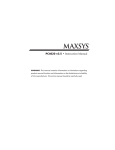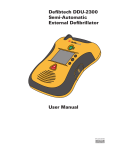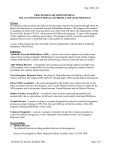Download Philips ForeRunner AED User Manual
Transcript
T HE F ORE R UNNER A ON/OFF: Initiates voice and screen prompts. Press again to turn off. B STATUS INDICATOR: Shows when the FORERUNNER is ready to use based on automatic self tests. M L C BATTERY LATCH: Slide to eject the battery. K ON• O A FF MICROPHONE: Located behind the battery latch. Records voice information when optional PC voice data card is installed. B C D E D OPTIONAL MANUAL OVERRIDE BUTTON: (Available on Model EM only) Permits qualified users to manually charge the FORERUNNER and deliver a shock. F E CONTRAST BUTTONS: Adjust LCD screen contrast and are used to control other functions. I J H G F DISPOSABLE/RECYCLABLE BATTERY: Provides power for the FORERUNNER. G OPTIONAL PC DATA CARD: Stores ECG and event data. An optional card can also store voice data. Separate cards provide setup and training options. H LCD SCREEN: Displays text prompts and patient/event information. ECG and heart rate can be displayed on Models E and EM. I J SHOCK BUTTON: Controls shock delivery. The button flashes when the FORERUNNER is ready to deliver a shock. SPEAKER: Provides audible instructions and information about the FORERUNNER and the patient’s status. K DEFIBRILLATION PAD PLACEMENT ILLUSTRATION. L CONNECTOR SOCKET: Insert the defibrillation pads connector into the connector socket. The LED flashes to indicate the socket location. The LED is covered when the defibrillation pad connector is properly inserted in the socket. M DEFIBRILLATION PADS: Disposable and self adhesive. Defibrillation pads include attached cable and connector. F O R E R U N N E R S E M I -A U T O M A T I C M O D E Q U I C K R E F E R E N C E ® s e m i - a u t o m a t i c d e fi b r i l l a t o r User’s Guide For Model S Model E Model EM ® Heartstream, the Heartstream logo, FORERUNNER, the FORERUNNER logo, and CODERUNNER are either registered trademarks or trademarks of Hewlett-Packard Company in the United States and/or other countries. The FORERUNNER semi-automatic defibrillator is sold in some markets as the Laerdal Heartstart FR. Laerdal and Heartstart are registered trademarks of Laerdal Medical Corporation. FORERUNNER as used in this document, refers to either the HP Heartstream FORERUNNER semi-automatic defibrillator or the Laerdal Heartstart FR. Specifications are subject to change without notice. Published in the U.S.A. CAUTION: Federal law (USA) restricts this device to sale by or on the order of a physician. ii F ORE R UNNER TABLE OF CONTENTS Introduction 1 Overview . . . . . . . . . . . . . . . . . . . . . . . . . . . . . . . . . . . . . . . . . . Indications . . . . . . . . . . . . . . . . . . . . . . . . . . . . . . . . . . . . . . . . . Contraindications . . . . . . . . . . . . . . . . . . . . . . . . . . . . . . . . . . . Dangers, Warnings, and Cautions . . . . . . . . . . . . . . . . . . . . . . Putting the FORERUNNER into Service 1 3 4 4 5 How to Put the FORERUNNER into Service . . . . . . . . . . . . . . . 5 Battery Installation and the Battery Insertion Test . . . . . . . . 6 Status Indicator and Automatic Self Tests . . . . . . . . . . . . . . 10 Using the FORERUNNER Preparation . . . . . . . . . . . . . . . . . . . . . . . . . . . . . . . . . . . . . . . Analysis and Monitoring . . . . . . . . . . . . . . . . . . . . . . . . . . . . Semi-automatic Delivery of Defibrillation Shock . . . . . . . . . Pause for CPR . . . . . . . . . . . . . . . . . . . . . . . . . . . . . . . . . . . . . Manual Delivery of Defibrillation Shock . . . . . . . . . . . . . . . Error Conditions, Possible Causes, and Corrective Actions. Continued Use. . . . . . . . . . . . . . . . . . . . . . . . . . . . . . . . . . . . . Maintaining the FORERUNNER Self Tests and FORERUNNER Maintenance . . . . . . . . . . . . . . Maintenance Schedule . . . . . . . . . . . . . . . . . . . . . . . . . . . . . . Cleaning . . . . . . . . . . . . . . . . . . . . . . . . . . . . . . . . . . . . . . . . . . Automated Defibrillators: Operator’s Check List . . . . . . . . . Event Review Storage and Retrieval 13 14 16 17 18 19 21 24 25 25 27 29 30 31 Installing the Optional PC Data Card . . . . . . . . . . . . . . . . . . 31 Event Review . . . . . . . . . . . . . . . . . . . . . . . . . . . . . . . . . . . . . 33 User’s Guide iii TABLE OF CONTENTS FORERUNNER Options 37 FORERUNNER Models . . . . . . . . . . . . . . . . . . . . . . . . . . . . . . . Using the FORERUNNER Setup Card . . . . . . . . . . . . . . . . . . . Configuring Setup Options. . . . . . . . . . . . . . . . . . . . . . . . . . . Training Options. . . . . . . . . . . . . . . . . . . . . . . . . . . . . . . . . . . Specifications 37 38 39 44 45 Technical Specifications . . . . . . . . . . . . . . . . . . . . . . . . . . . . . 46 Heartstream Clinical Summary and American Heart Association Defibrillation Statement . . . . . . . . . . . . . . . . . . . . . . . 55 Service and Replaceable Parts . . . . . . . . . . . . . . . . . . . . . . . . 57 Glossary of Symbols 59 FORERUNNER Symbols . . . . . . . . . . . . . . . . . . . . . . . . . . . . . . Screen Symbols . . . . . . . . . . . . . . . . . . . . . . . . . . . . . . . . . . . . PC Card Symbols . . . . . . . . . . . . . . . . . . . . . . . . . . . . . . . . . . . Battery Symbols . . . . . . . . . . . . . . . . . . . . . . . . . . . . . . . . . . . Dangers, Warnings, and Cautions 65 General . . . . . . . . . . . . . . . . . . . . . . . . . . . . . . . . . . . . . . . . . . Defibrillation . . . . . . . . . . . . . . . . . . . . . . . . . . . . . . . . . . . . . . Monitoring. . . . . . . . . . . . . . . . . . . . . . . . . . . . . . . . . . . . . . . . Maintenance . . . . . . . . . . . . . . . . . . . . . . . . . . . . . . . . . . . . . . iv 60 61 62 64 66 67 68 68 F ORE R UNNER C H A P T E R O N E Introduction T his User’s Guide provides information for trained operators about using and maintaining the FORERUNNER semi-automatic external defibrillator (AED). This chapter presents general information that you should know before you begin using the FORERUNNER. O VERVIEW 1 Overview 3 Indications 4 Contraindications 4 Dangers, Warnings, and Cautions User’s Guide The FORERUNNER semi-automatic defibrillator is lightweight, portable, and battery powered. It performs automatic self tests and displays the results of these tests on a Status Indicator. The FORERUNNER has an LCD screen that displays text prompts, patient and event information, and on some models, an electrocardiogram (ECG). 1 C ON Introduction H A P T E R E When connected with Heartstream defibrillation pads to a patient who is unconscious, not breathing, and without a pulse, the FORERUNNER: • • • • prompts you to take specific actions, automatically analyzes the patient’s ECG, indicates whether a shockable rhythm is present, and if so, arms the shock button. You can deliver the defibrillation shock by pressing the flashing shock button . The FORERUNNER will not deliver a shock unless the shock button is pressed. The FORERUNNER detects ECG signals and delivers the defibrillation shock using two self adhesive defibrillation pads. The defibrillation pads, cable, and connector are supplied as one disposable assembly. See Appendix B for information about shockable rhythms. The FORERUNNER determines proper defibrillation pad contact by monitoring impedance between the two attached defibrillation pads. The FORERUNNER recognizes a shockable rhythm (ventricular fibrillation or certain ventricular tachycardia) based on an ECG analysis system. The defibrillation shock is delivered using an impedance compensated biphasic waveform with a minimum of 130 Joules delivered to a 50 ohm load. Power is provided by a disposable, recyclable sealed lithium battery installed in the side of the FORERUNNER. Voice prompts provide instructions and patient information, and are reinforced by messages on the LCD screen. Adjacent pushbuttons control the FORERUNNER. An optional manual override button is available (Model EM only) for qualified users. It overrides the ECG analysis system and permits the operator to manually charge the FORERUNNER and deliver a shock. 2 F ORE R UNNER C ON Introduction H A P T E R E Optional PC data cards can record event information, ECG, voice, and other audible activity. Data stored on a card can be reviewed and reports can be generated using a personal computer. Optional training and setup cards allow the FORERUNNER to perform additional training and setup functions. Refer to the chapter on event review storage and retrieval for detailed information about using PC data cards and other options. I NDICATIONS The FORERUNNER, in semi-automatic or manual override mode, is indicated for use on victims of sudden cardiac arrest on whom an apparent lack of circulation is indicated by: • • • Unconsciousness Absence of breathing Absence of detectable pulse The FORERUNNER is for use by emergency care personnel specifically trained in the operation of the FORERUNNER and qualified by training in advanced cardiac life support, in basic life support, or in other physician-authorized emergency medical response. The FORERUNNER must be used by or on the order of a physician. The FORERUNNER was not designed or tested to interpret pediatric arrhythmias or administer energy at pediatric joule settings. For children older than 8 years, the American Heart Association recommends that standard operating procedures for AEDs be followed. American Heart Association. Textbook of Advanced Cardiac Life Support. Dallas, Tex: AHA; 1994. User’s Guide 3 C ON Introduction H A P T E R E C ONTRAINDICATIONS The FORERUNNER is contraindicated for use on patients exhibiting any one of the following: • • • Consciousness Presence of breathing Presence of detectable pulse D ANGERS , W ARNINGS , AND C AUTIONS This manual contains a list of danger, warning, and caution messages in Appendix D. These terms are used throughout this User’s Guide or on the FORERUNNER. Please familiarize yourself with their definitions and significance. 4 F ORE R UNNER C H A P T E R T W O Putting the FORERUNNER into Service Y ou need three items to put the FORERUNNER into service: the FORERUNNER, its battery, and the package containing the defibrillation pads with attached cable and connector. When you put the FORERUNNER into service, however, it is recommended that you carry a spare package of defibrillation pads, a spare battery, and a spare PC data card if the FORERUNNER uses this option. 5 How to Put the FORERUNNER into Service 6 Battery Installation and the Battery Insertion Test 8 Status Indicator and Automatic Self Tests H OW TO P UT THE FORERUNNER INTO S ERVICE The FORERUNNER is shipped with standard factory settings and without a PC data card. The settings should be reviewed against your program’s protocol and changed as needed. Failure to configure settings correctly may adversely affect use of the FORERUNNER. Installing a PC data card is optional. User’s Guide 5 CHAPTER TWO Putting the FORERUNNER into Service To put the FORERUNNER into service using the standard factory settings and no PC data card: For information about setup options and changing the factory settings, see Appendix A. For information about installing and using PC data cards, see the chapter on event review storage and retrieval. CAUTION: Follow all battery labeling instructions. Install the battery prior to the date noted on the battery. 1. Insert the battery and perform the Battery Insertion Test (BIT) as described on the following pages. 2. Put the FORERUNNER in an accessible area with the Status Indicator easily visible. See Appendix B for the environmental standby storage specifications. 3. Observe the Status Indicator daily and as described later in this chapter. B ATTERY I NSTALLATION AND THE B ATTERY I NSERTION T EST When you are ready to put the FORERUNNER into service, install the battery as shown below. Snap the battery into place using a single motion and firm pressure. The battery should “click” into place when it is properly inserted. FF ON• O 6 F ORE R UNNER CHAPTER TWO Putting the FORERUNNER into Service The Battery Insertion Test (BIT) At the time you install a battery, the FORERUNNER automatically performs a comprehensive self test called the Battery Insertion Test (BIT). The BIT has two parts: an automatic self test followed by an interactive test. During the automatic part of the BIT, the screen displays information about the progress of the self test. No user interaction is required during the automatic part of the BIT. If any portion of the BIT fails, replace the battery with a new battery and repeat the BIT. If any portion of the second BIT fails, remove the FORERUNNER from service and contact Heartstream Customer Service. If the screen displays a message that a previous self test has failed, the FORERUNNER must complete a BIT before being put into service. A message will also be displayed if the FORERUNNER has been stored outside of the recommended standby temperature range since the last BIT was completed. Storing the FORERUNNER outside of the standby temperature and environmental specifications noted in Appendix B will shorten battery life and prevent the FORERUNNER from performing self tests. The FORERUNNER performs a complete BIT when you install a battery unless: • • • • • • •O ON FF In an emergency, you press the On/Off button to stop the BIT. Defibrillation pads are attached to a patient, indicating that the FORERUNNER is in use. Less than five minutes have passed since the last use, indicating that it is likely the FORERUNNER is still in use. The FORERUNNER detects that a Training card or a Setup card is installed. The battery is completely depleted. The FORERUNNER is outside of the operating temperature specification. User’s Guide The Status Indicator tells you if the FORERUNNER passed the BIT. See the section later in this chapter titled Status Indicator and Automatic Self Tests. 7 CHAPTER TWO Putting the FORERUNNER into Service PC Data Card Verification The BIT automatically checks for the presence of the optional PC data card. If the PC data card is installed, the BIT verifies that the card is compatible with the FORERUNNER and that the FORERUNNER is able to communicate with the card. The FORERUNNER screen indicates whether the card has data from a previous event stored on it or is cleared of data. The FORERUNNER screen also indicates if an optional PC data card is not installed, if the card is incompatible with the FORERUNNER, or if the FORERUNNER system is unable to communicate with the card. If you get a screen prompt that alerts you that there is a data card error, remove the card. Ensure that the card is a Heartstream PC data card and it was installed correctly. If it is a Heartstream PC data card and was installed correctly, remove the card and contact Customer Service for a new card. Interactive Tests in the BIT When the automatic part of the BIT and PC data card verification are complete, the BIT begins interactive tests. These tests allow you to verify the correct operation of the screen, buttons, LEDs, and speaker on the FORERUNNER. The FORERUNNER screen guides you through these tests. Observe each test, follow the prompts as indicated, and note any discrepancies. If any portion of the BIT fails, replace the battery with a new battery and repeat the BIT. If any portion of the second BIT fails, remove the FORERUNNER from service and contact Customer Service. Descriptions of the interactive tests follow. 8 F ORE R UNNER CHAPTER TWO Putting the FORERUNNER into Service BIT Interactive Tests Description and Outcome of the Tests Speaker/Microphone An audible test of the speaker occurs when the screen message appears. You should hear two beeps during a successful test. LEDs Observe the two LEDs to verify that they both illuminate: A Connector socket LED. A B Shock button LED. B Contrast Buttons Press each contrast button when the screen prompt appears. Beeps and a screen message verify the test. LCD Screen Observe the test pattern on the LCD screen to verify operation and adjust the contrast as needed. A Contrast buttons: A Press to increase contrast. Press to decrease contrast. Shock Button Press the shock button when the screen prompt appears. A beep and screen message verify the test. Pressing the shock button will not deliver a shock during the BIT interactive test. Manual Override Button (Model EM only) If the FORERUNNER is equipped with a manual override button, slide the cover to expose the button. Press the manual override button when prompted. A beep and a screen message verify the test. On/Off N • OF O User’s Guide F Press On/Off when the screen prompt appears. A beep and screen message verify that the interactive portion of the BIT is complete. The FORERUNNER turns off. Observe the Status Indicator to determine if the FORERUNNER passed the BIT. 9 CHAPTER TWO Putting the FORERUNNER into Service S TATUS I NDICATOR AND A UTOMATIC S ELF T ESTS WARNING: The BIT and periodic self tests are designed to assess the FORERUNNER’s readiness for use. However, no degree of testing can assure performance or detect abuse, damage, or a defect which occurs after the last BIT or self test is completed. The Status Indicator displays the results of the last complete BIT or periodic self test. The BIT and self tests perform comprehensive checks of the internal electronics of the FORERUNNER. They do not, however, eliminate the need for FORERUNNER maintenance as specified in this User’s Guide. The Status Indicator has three operating conditions: Status Indicator Condition Action Alternates these two shapes The FORERUNNER passed the BIT or the last periodic automatic self test. The FORERUNNER is ready for use. Displays a flashing red X accompanied by a chirping sound The FORERUNNER requires attention. FORERUNNER use is not recommended because the FORERUNNER may not perform properly. A flashing red X can indicate: • Remove and reinstall the • a low battery • storage of the FORERUNNER outside of the recommended standby temperature range • a self test error 10 battery. A screen message will tell you if the standby temperature range has been exceeded. • Check to assure that the FORERUNNER is being stored in the recommended standby temperature range (see Appendix B). • If there is no "low battery" or "replace battery" screen message, remove and reinstall the existing battery and perform the BIT. If the BIT passes, the FORERUNNER is ready for use. If the BIT fails, install a new battery and repeat the BIT a second time. If the BIT passes, the FORERUNNER is ready to use. If the BIT fails, remove the FORERUNNER from service and contact Customer Service. F ORE R UNNER CHAPTER TWO Putting the FORERUNNER into Service Status Indicator Condition Action Displays a solid red X The FORERUNNER is not operable. Do not use the FORERUNNER. The solid red X can indicate: • Remove the Training or • a Training card is installed but unused for ten minutes. • a Setup card is installed. • the battery is missing or is completely depleted. • a self test detected a failure. Displays neither alternating hourglass, nor flashing or solid red X User’s Guide Possible damage to the FORERUNNER Setup card and reinsert the battery. • Remove and reinstall the battery to perform the BIT. If the BIT passes, the FORERUNNER is ready for use. If the BIT fails, install a new battery and repeat the BIT a second time. If the BIT passes, the FORERUNNER is ready to use. If the BIT fails, remove the ForeRunner from service and contact Customer Service. Remove and reinstall the battery to perform a BIT. If the BIT passes, the FORERUNNER is ready for use. If the BIT fails, install a new battery and repeat the BIT. If the BIT passes, the ForeRunner is ready for use. If the BIT fails, remove the FORERUNNER from service and contact Customer Service. 11 CHAPTER TWO Putting the FORERUNNER into Service 12 F ORE R UNNER C H A P T E R T H R E E Using the FORERUNNER T his chapter describes how to use the FORERUNNER in an emergency. The FORERUNNER automatically provides appropriate voice and display prompts to guide the operator through a variety of device and patient conditions. The steps for using the FORERUNNER in the semi-automatic mode are explained first. Use of the optional manual override button (Model EM) is described later in this chapter. Finally, this chapter describes corrective actions in cases when warnings or errors occur. 14 Preparation 16 Analysis and Monitoring 17 Semi-automatic Delivery of Defibrillation Shock 19 Manual Delivery of Defibrillation Shock 21 Error Conditions, Possible Causes, and Corrective Actions 24 Continued Use User’s Guide 13 CHAPTER THREE Using the FORERUNNER P REPARATION 1 •O ON FF •O ON FF Press the On/Off button to turn on the FORERUNNER. Follow the instructions provided by the FORERUNNER voice and screen prompts. Remove clothing from the patient’s chest. If necessary, wipe moisture from the patient’s chest and clip or shave excessive chest hair. Open the package containing the defibrillation pads with attached cable and connector. Pull off the protective backing from the defibrillation pads. Ensure the pads are free from obvious signs of damage and that the gel has not dried out. If the pads are damaged or the gel has dried out, use a new set of pads. Defibrillation pad placement is essential to successful defibrillation. Place one defibrillation pad just below the patient’s right clavicle. Place the second defibrillation pad over the ribs on the patient’s side in line with the axilla (armpit), and below the patient’s left breast. Refer to the diagram on the back of the defibrillation pads. Insert the defibrillation pads connector in the connector socket located by the flashing light. FF ON• O 14 F ORE R UNNER CHAPTER THREE Using the FORERUNNER WARNING: Use only Heartstream disposable defibrillation pads, batteries, and other accessories supplied by Heartstream or its authorized distributors. Substitution of non-Heartstream accessories may cause the device to perform improperly. CAUTION: Follow all defibrillation pad labeling instructions. Use defibrillation pads prior to expiration date. Discard defibrillation pads after use. Do not reuse defibrillation pads. WARNING: Do not place defibrillation pads in the anterior-posterior position. A shock or no shock decision may be inappropriately advised. The F ORERUNNER requires that the defibrillation pads be placed in the anterior-anterior position. WARNING: Do not allow defibrillation pads to touch each other, or to touch other ECG electrodes, lead wires, dressings, transdermal patches, etc. Such contact can cause electrical arcing and patient skin burns during defibrillation and may divert defibrillating current away from the heart. WARNING: During defibrillation, air pockets between the skin and defibrillation pads can cause patient skin burns. To help prevent air pockets, make sure defibrillation pads completely adhere to the skin. Do not use dried out defibrillation pads. DANGER: Possible explosion hazard if used in the presence of flammable anesthetics or concentrated oxygen. DANGER: The FORERUNNER has not been evaluated or approved for use in hazardous locations as defined in the National Electrical Code standard (Articles 500503). In compliance with the IEC classification (section 5.5) the F ORERUNNER is not to be used in the presence of flammable substance/air mixtures. WARNING: Improper use can cause injury. Use the FORERUNNER only as described in the User’s Guide. The FORERUNNER delivers electrical energy that can potentially cause death or injury if it is used or discharged improperly. Do not discharge with defibrillation pads together or open and exposed. CAUTION: Hazardous electrical output. This equipment is for use only by qualified personnel. CAUTION: Aggressive or prolonged CPR to a patient with defibrillation pads attached can cause damage to the pads. Replace the defibrillation pads if they become damaged during use. WARNING: Use of damaged equipment or accessories may cause the device to perform improperly and/or patient or user injury. User’s Guide 15 CHAPTER THREE Using the FORERUNNER A NALYSIS AND M ONITORING ON• O FF 2 WARNING: Handling or transporting the patient during ECG analysis can cause incorrect or delayed diagnosis. Following “Shock Advised” prompts, patient movement and vibration, if present, must be minimized for at least 15 seconds to allow reconfirmation of ECG analysis before delivering a shock. WARNING: In patients with cardiac pacemakers, the FORERUNNER may have reduced sensitivity and not detect all shockable rhythms. WARNING: Radio frequency (RF) interference from RF devices such as cellular phones and two-way radios may cause improper FORERUNNER operation. In accordance with IEC standard 801.3, a distance of 2 meters (6 feet) between RF devices and the FORERUNNER is recommended. WARNING: CPR rates above the American Heart Association guidelines of 100 BPM (beats per minute) can cause incorrect or delayed diagnosis. 16 Follow the instructions provided by the FORERUNNER voice and screen prompts. When the FORERUNNER is turned on and detects that the defibrillation pads are connected properly, it automatically begins analyzing ECG data to determine if a defibrillation shock is appropriate therapy. If there is ECG interference, the FORERUNNER provides voice and screen prompts that advise you to take action, such as "DO NOT TOUCH THE PATIENT", until the ECG interference stops. If No Shock is Advised Voice and screen prompts inform you when the FORERUNNER determines that no shock is advised. The FORERUNNER continues to monitor ECG data while you provide appropriate care to the patient. While the FORERUNNER is monitoring the patient, voice prompts are suppressed. While monitoring, if the FORERUNNER detects that the patient’s ECG changes to a potentially shockable rhythm or if the FORERUNNER is not able to analyze the rhythm because of interference, it will automatically shift to analyzing mode and give corresponding voice and screen prompts to advise you to respond appropriately. If No Shock is Advised and the No Shock Advised (NSA) Pause for CPR is Programmed Voice and screen prompts inform you when the FORERUNNER determines that no shock is advised. The FORERUNNER then pauses to allow time to administer CPR, if needed, without interruption. See Pause for CPR later in this chapter for more details. At the end of the pause for CPR, the FORERUNNER returns to monitoring the patient as described above. F ORE R UNNER CHAPTER THREE Using the FORERUNNER S EMI - AUTOMATIC D ELIVERY OF D EFIBRILLATION S HOCK 3 WARNING: Defibrillation current can cause operator or bystander injury. Do not touch the patient during defibrillation. Do not touch equipment connected to or metal objects in contact with the patient during defibrillation. Disconnect other electrical equipment from the patient before defibrillating. Disconnect the FORERUNNER from the patient prior to use of other defibrillators. User’s Guide Press the shock button to deliver the shock. The FORERUNNER requires five seconds of interference free ECG data to determine if a shock is appropriate therapy. When the FORERUNNER has analyzed the ECG data and determined that a defibrillating shock is appropriate, audible warnings and screen prompts tell you that a shock is advised and to stand clear of the patient. While the FORERUNNER charges, it continues to monitor ECG data. In the event a patient’s heart rhythm spontaneously returns to one for which shock is not advised, the FORERUNNER disarms. Voice and display prompts advise you what action to take. Note that when the FORERUNNER is fully charged, you can disarm it at any time by pressing the On/Off button to turn off the FORERUNNER. The FORERUNNER provides four ways of prompting a shock. Press the shock button when any of these occur: • a voice prompt instructs you to deliver a shock • the shock button flashes • you hear a steady tone • you see a screen prompt The FORERUNNER will not automatically deliver a shock. •O ON FF 17 CHAPTER THREE Using the FORERUNNER After you press the shock button , a voice prompt confirms that the shock was delivered and the FORERUNNER automatically resumes analyzing the ECG data to determine if the shock was effective. The FORERUNNER continues to provide voice and display prompts that guide you through additional shock sequences, if appropriate. The FORERUNNER also displays the number of shocks that have been delivered. If a series of unsuccessful shocks has occurred, the FORERUNNER will automatically pause for CPR (see Pause for CPR, CS Pause for CPR below). P AUSE FOR CPR A B 1:06 PAUSED 3 ATTEND TO PATIENT 18 The FORERUNNER automatically pauses to allow time to administer CPR with associated verbal and screen prompts at the beginning of the pause period. The FORERUNNER suppresses analysis and voice prompts during the pause to allow uninterrupted patient care. The heart rate display also is blank during the pause period. During a pause for CPR, the screen displays a bar that fills as the pause time elapses. A Bar indicates time remaining in the pause for CPR B Elapsed time since the FORERUNNER was turned on and the number of shocks delivered The FORERUNNER can be programmed with a setup card (see Appendix A for instructions) to provide two independent pause periods, a Consecutive Shock (CS) pause and a NO Shock Advised (NSA) pause. CS Pause The FORERUNNER can be set up to pause after a series of consecutive unsuccessful shocks. Typically, protocols advise up to three consecutive shocks, followed by a one minute pause for CPR. The FORERUNNER can be programmed, however, to change both the number of consecutive shocks before a pause and the duration of the CS pause period (see Appendix A for instructions). NSA Pause A pause for CPR following a No Shock Advised prompt is also available. As with the CS pause, the duration of the NSA pause is programmable. F ORE R UNNER CHAPTER THREE Using the FORERUNNER 1:06 PAUSED 3 RESUME ANALYZING If you use the MODEL E or MODEL EM, you can see the patient’s ECG trace on the screen. Resume Analysis During Pause All FORERUNNER models include an option that lets you quit the pause for CPR to manually resume ECG analysis. You can implement this option when you set up the FORERUNNER. See Appendix A for setup instructions. If this option is implemented, the screen includes a text prompt opposite a contrast button during a pause for CPR. To quit the pause for CPR and resume ECG analysis, press the contrast down button . At the end of the pause for CPR or when you resume analysis, the FORERUNNER advises you to stop moving the patient so it can perform analysis on the ECG data without interference. Voice and screen prompts guide you through additional shock sequences, if appropriate. M ANUAL D ELIVERY OF D EFIBRILLATION S HOCK The FORERUNNER Model EM includes a manual override button to allow qualified personnel the option to deliver a shock regardless of the FORERUNNER’s analysis of ECG data. You can use manual override after connecting the defibrillation pads. The manual override button does not function if: • the FORERUNNER Model EM analysis already indicates a CAUTION: The FORERUNNER manual override button is intended for use only by qualified operators who have been trained in rhythm recognition and treatment through manual charging and delivery of defibrillation shocks. User’s Guide shock is appropriate. • defibrillation pads are not attached. 19 CHAPTER THREE Using the FORERUNNER CAUTION: The LCD screen is intended only for basic ECG rhythm identification. The frequency response of the monitor screen is not intended to provide the resolution required for diagnostic and ST segment interpretation. To use the manual override button: 1. Slide the cover away from the manual override button. 2. Press the manual override button once to select the manual override mode. 3. Press manual override again within five seconds to charge the FORERUNNER Model EM so you can deliver a shock. The FORERUNNER is ready to deliver a shock when the shock button illuminates and flashes, and you hear a steady tone. 4. Press the shock button to deliver a shock. If you fail to press the manual override button a second time within 5 seconds, the FORERUNNER returns to semiautomatic operation; it analyzes the patient’s heart rhythm and illuminates the shock button if analysis determines that a shock is appropriate. DISARM If you decide against delivering the shock after the FORERUNNER Model EM is charged, press the manual override button to disarm and return to semi-automatic operation. The FORERUNNER automatically disarms and returns to semi-automatic operation after 30 seconds if the shock button has not been pressed. MANUAL OVERRIDE 20 F ORE R UNNER CHAPTER THREE Using the FORERUNNER E RROR C ONDITIONS , P OSSIBLE C AUSES , AND C ORRECTIVE A CTIONS If the FORERUNNER detects an error condition or system fault during use, it provides a voice or display prompt, or a combination of both. These are described below. Error Condition Possible Cause Corrective Action A screen prompt alerts you that the FORERUNNER is not ready for use or that a self test failed. The Status Indicator displays a flashing or solid red X. The FORERUNNER performs self tests when you turn it on and while it is in use. A test revealed a failure or error. Unplug the pads connector from the FORERUNNER. Remove and reinstall the battery to perform a BIT. If the BIT passes, the FORERUNNER is ready for use. If the BIT fails, install a new battery and repeat the BIT. If the BIT passes, the FORERUNNER is ready for use. If the BIT fails, remove the FORERUNNER from service and contact Customer Service. NOTE: You can stop the BIT and resume use of the FORERUNNER as soon as the status indicator changes to the alternating hourglass. A screen prompt alerts you to a low battery condition. The FORERUNNER battery is low. Battery failure may be imminent. Replace the battery as soon as possible. A screen prompt instructs you to replace the battery immediately. The Status Indicator displays a flashing red X. No power remains to continue operating the FORERUNNER. If you do not replace the battery, the FORERUNNER turns off. Replace the battery immediately. NOTE: Perform CPR (as necessary) any time there is a delay in FORERUNNER use. User’s Guide 21 CHAPTER THREE Using the FORERUNNER Error Condition Possible Cause Corrective Action Voice and screen prompts instruct you to attach the defibrillation pads and to plug in The defibrillation pads: • are not properly applied to the patient. • are not connected to the FORERUNNER. • are touching each other. • Ensure that the defibrilla- Voice and screen prompts instruct you to check the defibrillation pads or to press the defibrillation pads firmly to the patient’s chest. The defibrillation pads are not making proper contact with the patient’s bare chest. • Check the defibrillation Voice and screen prompts instruct you to replace the • The defibrillation pads, Replace the defibrillation pads. the connector. defibrillation pads. 22 tion pads connector is completely inserted in the connector socket. • Check the defibrillation pads on the patient and ensure that the pads adhere completely to the skin. • If necessary, wipe moisture from the patient’s chest and shave or clip excessive chest hair. • Replace the defibrillation pads if the prompt continues. pads on the patient and ensure that the pads adhere completely to the skin. • If necessary, wipe moisture from the patient’s chest and shave or clip excessive chest hair. • Replace the defibrillation pads if the prompt continues. cable, or connector may be damaged. • The FORERUNNER has detected a possible short in the defibrillation pads or cable. F ORE R UNNER CHAPTER THREE Using the FORERUNNER Error Condition Possible Cause Corrective Action Voice and screen prompts alert you that the ECG analysis has • Patient motion • Radio or electrical sources • Motion around the patient • Discontinue CPR; do not been interrupted. in a dry environment where significant static electricity is present Voice and screen prompts alert you that a shock was not delivered when you pressed the shock button . User’s Guide The FORERUNNER will not deliver a shock within specifications if the patient impedance is out of the specified range. touch the patient. Attempt to eliminate patient motion, if possible. • Stop the patient transport vehicle if needed. • Check for and remove possible causes of radio and electrical interference. • Check the defibrillation pads for proper placement. • Check the defibrillation pads connector. • Press the defibrillation pads firmly to the patient’s chest. • Replace the defibrillation pads if necessary. 23 CHAPTER THREE Using the FORERUNNER C ONTINUED U SE The FORERUNNER provides a feature called Continued Use to preserve the data recorded during an emergency event when you change a battery or turn the FORERUNNER off briefly. If the FORERUNNER is turned off and then on again during an emergency event, data on the card and in Summary Event Review is preserved and new data appended if: 1. The FORERUNNER is turned off for less than 5 minutes, or 2. The battery is removed for less than 30 seconds. Data preservation is not assured if the battery is removed for more than 30 seconds. Continued Use also allows you to quickly resume patient care when changing a battery during use. When a Continued Use occurs, the Battery Insertion Test is not done unless the status indicator shows the device is not ready for use. Then the test is run to attempt to clear any error conditions. 24 F ORE R UNNER C H A P T E R F O U R Maintaining the FORERUNNER T his chapter describes FORERUNNER automatic self tests and the occasional maintenance that you perform to assure that it is always ready for use. S ELF T ESTS AND FORERUNNER M AINTENANCE 25 Self Tests and FORERUNNER Maintenance 27 Maintenance Schedule 29 Cleaning 30 Automated Defibrillators: Operator’s Check List User’s Guide The FORERUNNER automatically performs periodic self tests when a battery is installed and has enough power to perform the tests. The FORERUNNER displays a message during these tests indicating that a self test is running. •O ON FF If you press On/Off during a self test, you discontinue the test. The test is automatically rescheduled. The results of the automatic self tests are displayed on the Status Indicator. 25 CHAPTER FOUR Maintaining the FORERUNNER The Status Indicator displays information about self test results: Alternates these shapes if the FORERUNNER passed the last self test. Flashing red X accompanied by a chirping sound indicates a self test error occurred or that the battery is low or depleted. Solid red X indicates the battery is completely depleted or a self test failure occurred. If the FORERUNNER passed its last automatic self test, the Status Indicator alternates between dark square and hourglass shapes. A self test error, storage of the FORERUNNER outside of the recommended temperature range, or a low or partially depleted battery results in a flashing X displayed on the Status Indicator accompanied by a chirping sound. A solid X is displayed if a Training or Setup Card is installed, the battery is missing or fully depleted, or a self test failure occurs. If the Status Indicator displays anything other than the alternating hourglass shapes, such as a constant dark shape or a flashing or solid X, remove the FORERUNNER from service. If there is no "low battery" or "replace battery" screen message, remove and reinstall the existing battery and perform the BIT as described in Chapter 2, Putting the FORERUNNER into Service. If the BIT passes and the Status Indicator alternates dark and hourglass shapes, return the FORERUNNER to service. If the BIT fails, install a new battery and repeat the BIT a second time. If the BIT passes, return the FORERUNNER to service. If the BIT fails, remove the FORERUNNER from service and contact Customer Service. The FORERUNNER is designed to be transported, stored, and operated within the environmental conditions specified in Appendix B. FORERUNNER performance may be decreased outside of these conditions. Self Tests During Use The FORERUNNER performs a Power On Self Test (POST) each time you turn it on. Self tests continue to monitor the hardware and software systems and battery while the FORERUNNER is in use. 26 FORERUNNER CHAPTER FOUR Maintaining the FORERUNNER M AINTENANCE S CHEDULE The following table provides suggested frequencies for maintenance. Different frequency intervals may be appropriate depending upon the environment in which the FORERUNNER is used, and is at the discretion of your program's medical director. Frequency Observe Take Action Daily, and after each use Check the Status Indicator. Verify that you see alternating dark and hourglass shapes that indicate the FORERUNNER is ready to use. If you see any condition other than the alternating dark square and hourglass shapes such as a constant dark shape, a flashing red X or a solid red X, do the following. If there is no "low battery" or "replace battery" screen message, remove and reinstall the existing battery and perform the BIT as described in Chapter 2, Putting the FORERUNNER into Service. If the BIT passes and the Status Indicator alternates dark and hourglass shapes, return the FORERUNNER to service. If the BIT fails, install a new battery and repeat the BIT a second time. If the BIT passes, return the FORERUNNER to service. If the BIT fails, remove the FORERUNNER from service and contact Customer Service. Ensure that all supplies, accessories, and spares are present, undamaged, and have not passed their expiration dates. Do not use damaged or expired supplies, accessories, or spares. Replace supplies, accessories, and spares as needed. Do not leave electrodes connected to the FORERUNNER when not in use. User’s Guide 27 CHAPTER FOUR Maintaining the FORERUNNER Frequency Observe Take Action Weekly and after each use Ensure the exterior of the FORERUNNER and the connector socket are free of cracks and signs of damage. Perform a BIT if the FORERUNNER is damaged or subjected to abuse. If cracks or damage are noted, remove the FORERUNNER from service and contact Heartstream Customer Service. After each use PC data card Remove the used PC data card and replace it with a spare according to instructions found in Chapter 5, Event Review Storage and Retrieval. Apply the patient ID label to the PC data card and deliver the card to appropriate personnel according to local guidelines and medical protocol. Ensure the FORERUNNER exterior and connector socket are free of dirt or contamination Status Indicator Clean the FORERUNNER, if needed. See the section later in this chapter titled Cleaning. Perform the BIT according to instructions in Chapter 2. Calibration is unnecessary as the FORERUNNER automatically performs daily self tests and correct operation is verified during the BIT. The F ORERUNNER does not require manual verification of energy delivery because monthly automatic self tests verify the waveform delivery system. The FORERUNNER has no user serviceable parts and Heartstream is the sole repair facility for the unit. As a result, we do not publish Service/Maintenance and Repair Manuals for technical professionals. CAUTION: Improper maintenance can cause the FORERUNNER not to function. Maintain the ForeRunner only as described in this User’s Guide or as designated by your program’s medical director. CAUTION: Electrical shock hazard. Dangerous high voltages and currents are present. Do not open unit, remove covers, or attempt repair. There are no user serviceable components in the FORERUNNER. Refer servicing to qualified service personnel. 28 FORERUNNER CHAPTER FOUR Maintaining the FORERUNNER C LEANING To clean the FORERUNNER, observe the following guidelines: • • • • The FORERUNNER should only be cleaned with the battery in place to keep fluids out of the PC data card slot and battery contact area. Use a soft cloth. Do not use abrasive materials, cleaners, or strong solvents such as acetone, or acetone based cleaners. Do not immerse the FORERUNNER in fluids. Clean the FORERUNNER and the connector socket with appropriate cleaning agents listed below. The connector socket includes a slot (A) to allow thorough cleaning. CAUTION: Do not immerse any portion of the FORERUNNER in water or other fluids. Do not allow fluids to enter the FORERUNNER. Avoid spilling any fluids on the FORERUNNER or accessories. Spilling fluids into the FORERUNNER may damage it or present a fire or shock hazard. Do not autoclave or gas sterilize the FORERUNNER or accessories. Use only the following cleaning agents: User’s Guide • OFF Isopropyl alcohol (70% Solution) Soapy water Chlorine bleach (30 ml/l water) Ammonia based cleaners Glutaraldehyde based cleaners Hydrogen peroxide ON • • • • • • A 29 CHAPTER FOUR Maintaining the FORERUNNER The following checklist is provided for your reference. A UTOMATED D EFIBRILLATORS : O PERATOR ’ S C HECK L IST FORERUNNER Model No.: __________ Serial No.: __________________________________ FORERUNNER Location or vehicle ID:____________________________________________ Inspect the FORERUNNER at frequencies specified in this chapter or as designated by your medical director. Indicate whether all requirements have been met. Note any corrective action taken. Sign at the bottom of the form. Date Frequency Interval FORERUNNER Unit Clean, no dirt or contamination; no damage present Supplies Available: a. Two sets defibrillation pads, sealed, within expiration date, undamaged b. Ancillary supplies (Hand towel, scissors, razor) c. Spare unopened battery within “Install Before” date d. PC data card undamaged, with spares* Status Indicator a. Self test okay, verify by noting Status Indicator Inspected by: Remarks, Problems, Corrective Actions * Applicable only if unit uses this option. 30 FORERUNNER C H A P T E R F I V E Event Review Storage and Retrieval T he FORERUNNER stores data in its own internal memory and on optional PC data cards supplied by Heartstream. Data stored in the FORERUNNER internal memory and the PC data card can be displayed on the FORERUNNER screen. Heartstream also provides CodeRunner® software to review, archive, and report the information stored on the PC data cards. I NSTALLING THE O PTIONAL PC D ATA C ARD 31 Installing the Optional PC Data Card 33 Event Review If you use the optional PC data card, the FORERUNNER can store and retrieve more detailed information about its own status and about emergency events. If you choose to use a PC data card, it must be installed before you put the FORERUNNER into service. User’s Guide 31 CHAPTER FIVE Event Review Storage and Retrieval Use only Heartstream PC data cards. Other data cards are not compatible with the FORERUNNER. To install the optional PC data card: FF ON• O PULL TAB 1. Remove the battery. 2. Make sure the card is clean, dry, and free of old patient identification labels. 3. Insert the PC data card in the slot with the arrow label facing up. 4. Push the card in until it is flush with the slot. Do not force the card into the slot. If the card is hard to insert, remove it and verify that the arrow label faces up. 5. Replace the battery and perform the BIT. 32 F ORE R UNNER CHAPTER FIVE Event Review Storage and Retrieval After each FORERUNNER use, replace the PC data card: 1. Remove the battery. 2. Pull the PC data card out by its pull tab. 3. Apply the patient ID label to the PC data card and deliver the card to the appropriate personnel. 4. Insert a new PC data card. 5. Replace the battery and perform the BIT. E VENT R EVIEW The FORERUNNER automatically stores information about a use of the FORERUNNER in an emergency event even if a PC data card is not used. This information can be displayed on the FORERUNNER screen. How to Display Event Review You can display a Summary or Full Event Review at any time unless: • • a FORERUNNER Training card is installed a FORERUNNER Setup card is installed User’s Guide 33 CHAPTER FIVE Event Review Storage and Retrieval To display the Event Review: 1. Turn off the FORERUNNER. 2. Press both contrast buttons while you press the On/Off button on the FORERUNNER. •O ON FF FF ON• O 34 F ORE R UNNER CHAPTER FIVE Event Review Storage and Retrieval Summary Event Review If a PC data card was not installed during the last emergency event, you can view Summary information on the FORERUNNER screen. Summary Event Review includes: • • the elapsed time that the FORERUNNER was on during the emergency event the number of shocks delivered You can display a Summary Event Review for the last emergency event until it is overwritten by the next new use of the FORERUNNER in an emergency event. Full Event Review PC data card options add information storage and retrieval capabilities to the Event Review. See Appendix B for information about PC data card capabilities. If a PC data card is installed, the FORERUNNER automatically stores Full Event Review information on the card. Full Event Review information includes: • • • • EVENT REVIEW PRESS OFF TO QUIT ELAPSED TIME 4:08 SHOCKS DELIVERED: 4 FIRST SHOCKS AT: 00:26 01:35 03:02 NEXT SCREEN the elapsed time that the FORERUNNER was on during the emergency event the number of shocks delivered the times of the first shocks delivered FORERUNNER related events and associated times User’s Guide 35 CHAPTER FIVE Event Review Storage and Retrieval Full Event Review appears on several screens in a sequence. The highlight bar appears on the lower line. Press the contrast down button to display the next screen. The data stored on the PC data card is overwritten by the next new use of the FORERUNNER in an emergency event. The data can be erased from the card by using the optional accessory software. 36 F ORE R UNNER A P P E N D I X A FORERUNNER Options F ORERUNNER models, setup options, and PC data card models let you customize the FORERUNNER to match your program’s protocol. This Appendix describes FORERUNNER options. FORERUNNER M ODELS The three available models are the FORERUNNER Model S, FORERUNNER Model E, and FORERUNNER Model EM. 37 FORERUNNER Models 38 Using the FORERUNNER Setup Card 39 Configuring Setup Options 44 Training Options The FORERUNNER Model S is the standard model. The FORERUNNER Model S does not display an ECG trace or heart rate. The FORERUNNER Model E (enhanced) adds the option to display heart rate and an ECG trace. You select the display options using the FORERUNNER Setup card before you put the FORERUNNER into service. The FORERUNNER Model EM (enhanced manual) always displays heart rate and an ECG trace, and has the manual override button. User’s Guide 37 A A FORERUNNER Options P P E N D I X U SING THE FORERUNNER S ETUP C ARD Before you put a FORERUNNER into service, you should configure options to match your program’s protocol using the FORERUNNER Setup card. Failure to configure settings correctly may adversely affect use of the FORERUNNER. To configure options, install the FORERUNNER Setup card: FF ON• O 1. Remove the battery. 2. Insert the Setup card in the slot with the arrow label facing up. 3. Push the card in until it is flush with the slot. Do not force the card into the slot. If the card is difficult to insert, remove it and verify that the arrow label faces up. 4. Replace the battery. When you install the Setup card, the FORERUNNER automatically turns on with the setup options displayed on the screen. No BIT takes place. 38 FORERUNNER APPENDIX A FORERUNNER Options While the Setup card is installed: • • • • •O ON FF the On/Off button is disabled the FORERUNNER is operable only for setup functions the Status Indicator shows a solid red X if no buttons are pressed for five minutes, the FORERUNNER “chirps” to prompt you to continue the setup or remove the Setup card At the completion of the setup, remove the Setup card, replace the battery, and perform the BIT to put the FORERUNNER into service. C ONFIGURING S ETUP O PTIONS Setup options are described below. Press the contrast down button to move between menu items. Press the contrast up button to choose or change an option. Setup options are saved automatically in the FORERUNNER when you quit setup. User’s Guide 39 A A FORERUNNER Options P P E N D I X General Setup Options Menu item Options Factory Settings Prompts Short or Long. Long voice prompts contain more descriptive information. Short voice prompts are intended for use by more experienced responders. Long Speaker Volume 1-8. Eight possible settings. 8 is full volume. 8 ECG Record Std or Low. Std records ECG data on PC data cards at 200 data samples per second; low at 100 samples per second. Low resolution recording provides a longer ECG recording. Std resolution provides research quality ECG recording. Std ECG Displayed (Model E only) Yes or no. ECG is displayed on the screen. Yes. ECG display on. (ECG is always displayed on Model EM.) Go to CPR Protocol Displays options to customize the CPR and Shock sequence. See CPR Protocol Setup Options that follow. Go to Device History Displays Device History. See Device History information that follows. 40 FORERUNNER APPENDIX A FORERUNNER Options CPR Protocol Setup Options Menu item Options Factory Settings Shocks 1, 2, or 3. Number of shocks delivered in a sequence before the FORERUNNER will pause for CPR. 3 shocks Consecutive Shock (CS) CPR Timeout 0, 0.5, 1.0, 1.5, 2.0, 2.5, 3.0, or ∞. CS CPR Timeout is the interval in minutes provided for CPR after each Shock sequence. The FORERUNNER automatically pauses for CPR after the setup number of consecutive shocks. It resumes analyzing automatically at the end of the CPR Timeout or when the Resume Analyzing button is pressed by the user. If CPR Timeout is set to ∞, the automatic resume analyzing is disabled, and the user MUST press the Resume Analyzing button to quit the pause for CPR. 1.0 minute No Shock Advised (NSA) CPR Timeout 0, .25, 0.5, 1.0, 1.5, 2.0, 3.0, and ∞. NSA CPR Timeout is the interval in minutes provided for CPR immediately after a No Shock Advised condition. See CS CPR Timeout for Resume Analyzing details. 0 minutes User’s Guide 41 A A FORERUNNER Options Resume Analysis 42 P P E N D I X ON or OFF. ON activates a Resume Analyzing button to allow you to manually quit the pause for CPR and resume ECG analysis. OFF inhibits activation of the Resume Analyzing button. NOTE: ON is the only choice available if you select a CPR Timeout greater than 60 seconds. OFF (ON if CPR Timeout is greater than 60 seconds) FORERUNNER APPENDIX A FORERUNNER Options FORERUNNER Device History Information about the FORERUNNER automatically accumulates in its internal memory throughout the FORERUNNER’s lifetime. When you select the Device History option on the Setup card, a screen displays the following information. Device History Display Screen Display Options USES: The first number is the cumulative number of new uses during the FORERUNNER lifetime. The cumulative time (in minutes) of all FORERUNNER uses in which defibrillation pads were connected to the patient during emergency events is indicated by the second number. SHOCKS: Cumulative number of shocks delivered by the FORERUNNER in its lifetime. TRAINING: The first number is the cumulative number of times the Training card was inserted and used during the FORERUNNER’s lifetime. The cumulative training time (in minutes) is indicated by the second number. TESTS: Cumulative number of tests that have been performed during the FORERUNNER’s lifetime. A: B: C: D: User’s Guide Number of daily automatic self tests Number of weekly automatic self tests Number of monthly automatic self tests Number of Battery Insertion tests 43 A A FORERUNNER Options P P E N D I X T RAINING O PTIONS Heartstream offers an optional FORERUNNER Training card and user’s guide. The FORERUNNER Training card includes simulated scripts that guide responders through several emergency events. A training card must always be installed in the FORERUNNER when using it for training or demonstration purposes. When the training or demonstrations are complete, remove the training card to return the FORERUNNER to service and prevent battery depletion. 44 FORERUNNER A P P E N D I X B Specifications T his appendix presents technical specifications, waveform specifications, a clinical summary, and information about service and replaceable parts. 46 Technical Specifications 54 Heartstream Clinical Summary and American Heart Association Defibrillation Statement 57 Service and Replaceable Parts User’s Guide 45 A P P E N D I X B Specifications T ECHNICAL S PECIFICATIONS Physical Category Specification Size 2.53 inches high x 8.75 inches wide x 8.0 inches deep (64 mm x 223 mm x 203 mm) Weight Approximately 2 kg (4.4 lbs) with battery installed. Environmental Category Specification Operating Temperature/ Humidity 0 to 50˚C (32 to 122˚F), 0% to 95% Relative Humidity (noncondensing). Standby Temperature/Humidity 10 to 43˚C (50 to 109˚F), 0% to 75% Relative Humidity (noncondensing). FORERUNNER with battery installed, stored with defibrillation pads. Altitude -500 to 15,000 feet per MIL-810E 500.3 Procedure II. Shock/Drop Abuse Tolerance MIL-STD-810E 516.4 Procedure IV (1 meter, any edge, corner, or surface). Vibration MIL-STD-810E 514.4-17. Sealing IEC 529 class IP54; Splash Proof, Dust Protected. ESD IEC 801-2 Severity Level 4. EMI (Radiated) CISPR11 Group 1 Level B. EMI (Immunity) IEC 801-3 Level 2. Transportation Environment RTCA/DO-16OC “Environmental conditions and test procedures for airborne equipment”. 46 FORERUNNER A P P E N D I X B Specifications Defibrillator Category Specification Waveform Truncated Exponential Biphasic. Waveform parameters are adjusted as a function of patient defibrillation impedance. Energy/Energy Selection Single Energy—a nominal of 150 Joules (minimum of 130 Joules) delivered to a 50 ohm load. Charge Control Under control of the Patient Analysis System for semi-automatic operation. The manual override button allows manual charge control (FORERUNNER Model EM only). Charge Time from Shock Advised Typically less than 10 seconds. Charge time increases at the end of battery life as well as at temperatures below 10°C. Shock-to-Shock Cycle Time Typically less than 20 seconds (including analysis time) in semiautomatic mode. Charge Complete Indication FORERUNNER is ‘armed’ when shock button is flashing and armed tone is activated. Shock Discharge Control Shock is delivered by a single shock button. Disarm–Semi-Automatic Operation Once the FORERUNNER is charged, it will disarm under any of the following conditions: • a no shock decision is reached • the FORERUNNER On/Off button is pressed and the FORERUNNER is turned off • the defibrillation pads are removed from the patient or the pads connector is disconnected from the FORERUNNER Disarm–Manual Operation Once the FORERUNNER is charged, it will disarm under any of the following conditions: • 30 seconds after charging if a shock is not delivered • manually by pressing the manual override button • the FORERUNNER On/Off button is pressed and the FORERUNNER is turned off • the defibrillator pads are removed from the patient or the pads connector is disconnected from the FORERUNNER User’s Guide 47 A P P E N D I X B Specifications Category Specification Shock Delivery Via defibrillation pads placed in the anterior-anterior (Lead II) position. Patient Analysis System Category Specification Patient Analysis Evaluates defibrillation pads’ impedance for proper defibrillation pad contact, and evaluates patient ECG and signal quality to determine if a shock is appropriate. Protocols Follows pre-configured settings to match your program’s protocols. These settings can be modified using the setup options. Shockable Rhythms VF and certain VT rhythms (including ventricular flutter and polymorphic VT). WARNING: Some very low amplitude or low frequency rhythms may not be interpreted as shockable VF rhythms. Also, some VT rhythms may not be interpreted as shockable rhythms. 48 FORERUNNER A B P P E N D I X Specifications Patient Analysis System Performance Rhythm Class ECG Test Sample1 Size Specification Shockable Rhythm - VF 300 FORERUNNER meets the AAMI DF39 requirement and AHA recommendation2 of Sensitivity>90% Shockable Rhythm - VT 100 FORERUNNER meets the AAMI DF39 requirement and AHA recommendation2 of Sensitivity>75% Non-shockable rhythm - Normal sinus rhythms 300 FORERUNNER meets the AAMI DF39 requirement of Specificity>95% and AHA recommendation2 of Specificity>99% Non-shockable rhythm - Asystole 100 FORERUNNER meets the AAMI DF39 requirement and AHA recommendation2 of Specificity>95% Non-shockable rhythm - all other non-shockable rhythms 450 FORERUNNER meets the AAMI DF39 requirement and AHA recommendation2 of Specificity>95% 1 From Heartstream ECG rhythm databases. 2 Automatic External Defibrillators for Public Access Use: Recommendations for Specifying and Reporting Arrhythmia Analysis Algorithm Performance, Incorporation New Waveforms, and Enhancing Safety, American Heart Association (AHA) AED Task Force, Subcommittee on Safety & Efficacy, draft 3/18/96, Table 2. User’s Guide 49 A P P E N D I X B Specifications ECG Display (Available only on Model E and Model EM) Category Specification Monitored Lead ECG information is acquired through defibrillation pads in anterior-anterior (Lead II) placement. Display Range Differential: ±2 mV full scale nominal. Screen High resolution LCD with backlight. Screen Dimensions 2.8 inches wide x 2.3 inches high (70 mm x 58 mm). Sweep Speed 23 mm/sec. nominal. Frequency Response (Bandwidth) Nondiagnostic rhythm monitor 1 Hz to 20 Hz (-3 dB) nominal. Sensitivity 1.16 cm/mV nominal. Heart Rate (Normal Sinus Rhythm) Displays a range of 30 to 300 beats per minute updated each analysis period. Heart rate is displayed only during monitoring mode and if ECG is displayed. Battery Pack Category Specification Battery 18 VDC 1300 mAH lithium. Disposable, recyclable, long-life, primary cells. Capacity A new battery typically will provide 100 shocks or 5 hours of operating time, or 10 hours of training time at 25˚C. Shelf-Life Typically 5 years from date of manufacture when stored at standby environmental conditions in original, unopened packaging. Standby Life Typically more than one (1) year when stored under standby environmental conditions (1 battery insert test and no uses or training). Low Battery Detection Defibrillator detects low battery condition during daily periodic self tests. Replace the battery when the Status Indicator shows a solid or flashing red X. 50 FORERUNNER A P P E N D I X B Specifications Controls and Indicators Category Specification Main LCD screen A high resolution, backlit LCD screen displays ECG (MODELS E and EM) and informational/instructional text messages on all models. Controls On/Off button Shock button Manual override button (MODEL EM Only) Contrast up button Contrast down button LED Indicators Connector socket LED illuminates and flashes to indicate the socket location and is covered when the defibrillation pad connector is properly inserted. The shock button illuminates (flashes) when the defibrillator is armed. Audio Speaker An audio speaker provides voice prompts. Volume of voice prompts is adjustable using the Setup card. Beeper The beeper chirps as an alert when a self test has failed (standby mode), and generates various warning tones during normal use. Status Indicator A Status Indicator LCD displays the results of the last self test. •O ON FF Defibrillation Pads Category Specification Defibrillation Pads, Cable, and Connector Disposable and self adhesive. Defibrillation pads have a nominal active surface area of 100 cm2 each and are provided in a sealed package with an integrated 122 cm (48 inch), typical, long cable and connector. Defibrillation Pad Requirements Use only Heartstream defibrillation pads with the FORERUNNER. Place the pads in standard anterior-anterior position. User’s Guide 51 A P P E N D I X B Specifications PC Data Cards, Training and Setup Cards (Options) All FORERUNNER models come equipped with built in hardware and software that enable the defibrillator to perform additional medical control, setup, and training functions when used with optional Heartstream Setup, Training, and PC data cards. The information stored on the data cards can be reviewed using optional software. Category Specification Event Review Card Provides the FORERUNNER with Event Review capability and 15 minutes of ECG data collection. This card incorporates a real time clock which provides a means for synchronizing the EMS system time with the recorded code events. Full ECG Card Provides the FORERUNNER with Event Review capability as well as providing a maximum of 30 minutes of ECG data collection. A real time clock is also incorporated in this card. Voice and ECG Card Same as Full ECG Card with the added capability of digitally recording a maximum of 26 minutes per use near area sounds and voices. Sound recording is synchronized with ECG and event data. Training Card When the Training card is installed, the FORERUNNER operates in a special training mode which provides several training scenarios. Use of the Training card and training scenarios are described in the Training card user’s guide. Setup Card Provides the system administrator with a means to tailor the FORERUNNER to your program’s protocol. 52 FORERUNNER A P P E N D I X B Specifications Waveform Specifications The FORERUNNER defibrillator delivers patient-compensated biphasic truncated exponential waveforms with a nominal of 150 Joules (minimum of 130 Joules) delivered to a 50 ohm load. 2000 Phase 1 Duration BITE Vpeak Phase 2 Duration Interphase Delay Voltage (V) 1500 1000 500 0 Vfinal -500 -1000 -1 0 1 2 3 4 5 6 7 8 9 10 Time (ms) The “BITE” is the biphasic initiation and termination element, and is used to determine whether the load impedance is within an acceptable range. The FORERUNNER defibrillator delivers shocks to load impedances from 25 to 180 ohm. The duration of each phase of the waveform is dynamically adjusted based on delivered charge in order to compensate for patient variability as follows: Load Resistance (Ω) Phase 1 Duration (ms) Phase 2 Duration (ms) 25 ± 1% 2.83 ± 5% 2.83 ± 5% 88 90 130 182 50 ± 1% 4.09 ± 5% 4.09 ± 5% 78 81 130 178 100 ± 1% 8.95 ± 5% 5.97 ± 5% 75 78 131 176 125 ± 1% 12.00 ± 5% 8.00 ± 5% 77 81 132 178 User’s Guide Total Tilt (%) min max Delivered Energy (J) min max 53 A P P E N D I X B Specifications Total tilt is defined as the percent voltage decay from the peak voltage of the first phase to the final voltage of the second phase: ( V peak – V final ) Total Tilt = ---------------------------------------- × 100 % V peak The interphase delay between phases of the waveform is 400 ± 50 µsec. H EARTSTREAM C LINICAL S UMMARY AND A MERICAN H EART A SSOCIATION D EFIBRILLATION S TATEMENT Overview and Objective Heartstream conducted a study to assess the performance of our 150 J impedance-compensating biphasic waveform in the out-of-hospital setting on 100 consecutive victims of sudden cardiac arrest treated by a wide range of first-responders, both traditional and non-traditional. AEDs incorporating 150 J impedance-compensating biphasic waveforms were placed into service of 34 EMS systems. Data were obtained from the AED PC data card recording system. The first endpoint was to determine the effectiveness of this waveform at terminating VF. Defibrillation was defined using the standard definition of conversion to an organized rhythm or to asystole. The second endpoint was to determine whether or not the use of such an AED culminated in an organized rhythm at the time of patient transfer to an advanced life support (ALS) team or 54 FORERUNNER A P P E N D I X B Specifications emergency department (ED). The third endpoint was to assess the efficiency of the human factors design of the AED by measuring user time intervals. Results Thirty-four sites provided data on 286 consecutive AED uses, 100 from SCA victims with VF as their initial rhythm upon attachment of the AED. All 286 patients were correctly identified by the AED as requiring a shock (100% sensitivity to the 100 VF patients) or not (100% specificity to the 186 patients not presenting in VF). The time from emergency call to first shock delivery averaged 9.1+/- 7.3 minutes. A single 150 J biphasic shock defibrillated the initial VF episode in 86% of patients. For all 450 episodes of VF in these 100 patients, an average of 86%+/- 24% of VF episodes was terminated with a single biphasic shock. Of the 449 VF episodes that received up to three shocks, 97%+/- 11% were terminated with three shocks or fewer. The average number of shocks per VF episode was 1.3+/- 0.7. The average time from AED poweron and pads attached to first defibrillation was 25+/- 23 seconds. At the time of patient transfer, an organized rhythm was present in 65% of patients presenting with VF. Asystole was the result in 25% of patients and VF was in progress in 10% of patients at the time of transfer. Conclusions Low-energy impedance-compensating biphasic waveforms terminate long-duration VF at high rates in out-of-hospital cardiac arrest and provide defibrillation rates exceeding those previously published with high-energy shocks. Use of this waveform allows AED device characteristics consistent with widespread AED deployment and early defibrillation. Gliner BE, et al. Treatment of out-of-hospital cardiac arrest with a low-energy impedancecompensating biphasic waveform automatic external defibrillator. Biomedical Instrumentation & Technology, 1998;32:xx-xx. User’s Guide 55 A P P E N D I X B Specifications AMERICAN HEART ASSOCIATION DEFIBRILLATION STATEMENT A recent (April 1998) scientific statement by the American Heart Association determined that the FORERUNNER’s waveform is "safe, acceptable and clinically effective." In its conclusions, the AHA gave the use of the low-energy, impedance-compensating biphasic waveform a Class IIb recommendation, making it the only defibrillation waveform to date to receive an AHA class recommendation. 56 FORERUNNER A P P E N D I X B Specifications S ERVICE AND R EPLACEABLE P ARTS There are no user serviceable components in the FORERUNNER. Contact Customer Service about returning a FORERUNNER that has suspected operating problems. Calibration is unnecessary as the FORERUNNER automatically performs daily self tests and correct operation is verified during the BIT. The FORERUNNER does not require manual verification of energy delivery because monthly automatic self tests verify the waveform delivery system. As a result, we do not publish Service/Maintenance and Repair Manuals for technical professionals. CAUTION: Electrical shock hazard. Dangerous high voltages and currents are present. Do not open unit, remove covers, or attempt repair. There are no user serviceable components in the FORERUNNER. Refer servicing to qualified service personnel. Items that can be ordered routinely include: • • • • • • • • PC data cards and patient identification labels FORERUNNER Training card FORERUNNER Setup card FORERUNNER battery pack FORERUNNER package containing defibrillation pads, cable, and connector FORERUNNER carrying case Mannequin adaptors FORERUNNER accessory software Contact Customer Service or your local distributor for ordering information. User’s Guide 57 A P P E N D I X B Specifications 58 FORERUNNER A P P E N D I X C Glossary of Symbols T his appendix includes a glossary of symbols. 60 FORERUNNER Symbols 61 Screen Symbols 62 PC Card Symbols 64 Battery Symbols User’s Guide 59 APPENDIX C Glossary of Symbols FORERUNNER S YMBOLS Icon Description Turns the FORERUNNER on or off. On/Off button •O ON FF Shock button Delivers shock to patient when the FORERUNNER is charged. Manual override button Initiates manual override delivery of shock. Contrast up button Increases the screen contrast or performs the function indicated on the screen. Contrast down button Decreases the screen contrast or performs the function indicated on the screen. Defibrillation protection Defibrillation protected, type BF patient connection. High voltage present. Refer to operating instructions. 60 FORERUNNER APPENDIX C Glossary of Symbols S CREEN S YMBOLS Icon Description HR XX Heart Rate. HR - - - Heart Rate not available. Number of shocks delivered. X XX:XX Temperature Setup REV: XXXX XXXX User’s Guide Elapsed time since the FORERUNNER was turned on. The recommended standby storage temperature range has been exceeded since the last BIT was performed. Check to assure that the FORERUNNER is stored within the range specified in Appendix B. The setup options configuration has been lost from memory. The FORERUNNER is using the default factory settings. To clear this message, use the Setup card described in Appendix A. If the message persists after you use the Setup card, call Customer Service. The “REV” number identifies the version of software and hardware used in your FORERUNNER. 61 APPENDIX C Glossary of Symbols PC C ARD S YMBOLS Icon Meaning Training card The Training card includes several simulated scenarios that guide students through several emergency events. Setup card The Setup card allows you to configure options to match your program’s protocol. Event Review card Event Review recording capability. Full ECG card Event Review with ECG recording capability. Voice and ECG card Event Review with ECG and voice recording capability. 62 FORERUNNER APPENDIX C Glossary of Symbols Icon Meaning Insert Insert the data card into the FORERUNNER with this side up. For use until The PC data card contains a battery. Do not use the PC data card after the date indicated because the battery may be low or depleted. LOT 1 2 3 4 5 6 7 8 9 FOR USE UNTIL: 1998-02 User’s Guide 63 APPENDIX C Glossary of Symbols B ATTERY S YMBOLS Icon Meaning Do not crush the battery. Do not expose the battery to high heat or open flames. Do not incinerate. Do not mutilate the battery or open the battery case. Install Before Install the battery in the FORERUNNER prior to the date indicated. Do not install the battery after this date. Heavy metal substances. Do not dispose of improperly. Collect and recycle separately from household wastes. Li 64 FORERUNNER A P P E N D I X D Dangers, Warnings, and Cautions T his Appendix includes the list of danger, warning, and caution messages. CAUTION Conditions, hazards, or unsafe practices that can result in minor personal injury, damage to the FORERUNNER, or loss of data. WARNING 66 General 67 Defibrillation 68 Monitoring 68 Maintenance User’s Guide Conditions, hazards, or unsafe practices that can result in serious personal injury or death. DANGER Immediate hazards which will result in serious personal injury or death. 65 APPENDIX D Dangers, Warnings, and Cautions G ENERAL Possible Shock or Fire Hazard or Explosion DANGER: Possible explosion hazard if used in the presence of flammable anesthetics or concentrated oxygen. WARNING: Improper use can cause injury. Use the FORERUNNER only as described in the User’s Guide. The FORERUNNER delivers electrical energy that can potentially cause death or injury if it is used or discharged improperly. Do not discharge with defibrillation pads together or open and exposed. CAUTION: Hazardous electrical output. This equipment is for use only by qualified personnel. CAUTION: Do not immerse any portion of the FORERUNNER in water or other fluids. Do not allow fluids to enter the FORERUNNER. Avoid spilling any fluids on the FORERUNNER or accessories. Spilling fluids into the FORERUNNER may damage it or present a fire or shock hazard. Do not autoclave or gas sterilize the F ORERUNNER or accessories. DANGER: The FORERUNNER has not been evaluated or approved for use in hazardous locations as defined in the National Electrical Code standard (Articles 500503). In compliance with the IEC classification (section 5.5) the ForeRunner is not to be used in the presence of flammable substance/air mixtures. Possible Improper Device Performance WARNING: Use only Heartstream disposable defibrillation pads, batteries, and other accessories supplied by Heartstream or its authorized distributors. Substitution of non-Heartstream accessories may cause the device to perform improperly. CAUTION: Follow all defibrillation pad labeling instructions. Use defibrillation pads prior to their expiration date. Discard defibrillation pads after use. Do not reuse defibrillation pads. CAUTION: Follow all battery labeling instructions. Install the battery prior to the date noted on the battery. WARNING: The BIT and periodic self tests are designed to assess the FORERUNNER’s readiness for use. However, no degree of testing can assure performance or detect abuse, damage, or a defect which occurs after the last BIT or self test is completed. CAUTION: Although the FORERUNNER is designed for a wide variety of field use conditions, rough handling beyond specifications can result in damage to the unit. (See Environmental Specifications in Appendix B.) 66 FORERUNNER APPENDIX D Dangers, Warnings, and Cautions WARNING: Aggressive or prolonged CPR to a patient with defibrillation pads attached can cause damage to the pads. Replace the defibrillation pads if they become damaged during use. WARNING: Use of damaged equipment or accessories may cause the device to perform improperly and/or patient or user injury. WARNING: CPR rates above the American Heart Association guidelines of 100 BPM (beats per minute) can cause incorrect or delayed diagnosis. Possible Electrical Interference with ECG monitoring WARNING: Radio frequency (RF) interference from RF devices such as cellular phones and two-way radios can cause improper F ORERUNNER operation. In accordance with IEC standard 801.3, a distance of 2 meters (6 feet) between RF devices and the FORERUNNER is recommended. D EFIBRILLATION Possible Shock Hazard WARNING: Defibrillation current can cause operator or bystander injury. Do not touch the patient during defibrillation. Do not touch equipment connected to or metal objects in contact with the patient during defibrillation. Disconnect other electrical equipment from the patient before defibrillating. Disconnect the FORERUNNER from the patient prior to use of other defibrillators. Possible Patient Safety CAUTION: The FORERUNNER manual override button is intended for use only by qualified operators who have been trained in rhythm recognition and treatment through manual charging and delivery of defibrillation shocks. Possible ECG Misinterpretation WARNING: Do not place defibrillation pads in the anterior-posterior position. A shock or no shock decision may be inappropriately advised. The FORERUNNER requires that the defibrillation pads be placed in the anterioranterior position. WARNING: Some very low amplitude or low frequency rhythms may not be interpreted as shockable VF rhythms. Also, some VT rhythms may not be interpreted as shockable rhythms. WARNING: Handling or transporting the patient during ECG analysis can cause incorrect or delayed diagnosis especially if very low amplitude or low fre- User’s Guide 67 APPENDIX D Dangers, Warnings, and Cautions quency rhythms are present. Following “Shock Advised” prompts, patient movement and vibration, if present, must be minimized for at least 15 seconds to allow reconfirmation of ECG analysis before delivering a shock. This reconfirmation of ECG analysis may result in an appropriate reversal of a "Shock Advised" prompt. WARNING: In patients with cardiac pacemakers, the FORERUNNER may have reduced sensitivity and not detect all shockable rhythms. Possible Burns and Ineffective Energy WARNING: Do not allow defibrillation pads to touch each other, or to touch other ECG electrodes, lead wires, dressings, transdermal patches, etc. Such contact can cause electrical arcing and patient skin burns during defibrillation and may divert defibrillating current away from the heart. WARNING: During defibrillation, air pockets between the skin and defibrillation pads can cause patient skin burns. To help prevent air pockets, make sure self-adhesive defibrillation pads completely adhere to the skin. Do not use dried out defibrillation pads. M ONITORING Possible Misinterpretation of ECG Recordings CAUTION: The LCD screen is intended only for basic ECG rhythm identification. The frequency response of the monitor screen is not intended to provide the resolution required for diagnostic and ST segment interpretation. M AINTENANCE Possible Fire or Shock Hazard CAUTION: Electrical shock hazard. Dangerous high voltages and currents are present. Do not open unit, remove covers, or attempt repair. There are no user serviceable components in the FORERUNNER. Refer servicing to qualified service personnel. Possible Improper Device Performance CAUTION: Improper maintenance can cause the FORERUNNER not to function. Maintain the FORERUNNER only as described in this User’s Guide or as instructed by your medical director. 68 FORERUNNER I N D E X A accessories available to order 57 maintaining 27 adjust contrast during BIT 9 AED overview 1 analysis requirements for shock decision 17 applying defibrillation pads to the patient 14 artifact 16, 23, 67 attaching pads 14 B battery conditions and Status Indicator 10, 21 dead or depleted 11, 21 insertion 6 maintenance 25, 27 position during cleaning 29 specifications 50 symbols 64 testing 25 Battery Insertion Test (BIT) 7 how to interrupt 7 interactive tests 8 biphasic waveform 47, 53 BIT. See Battery Insertion Test. burn hazard 68 C cautions, warnings, and dangers 65 charge release when no shock delivered 17 chirping due to low battery or self test failure 10, 26 due to setup card 39 cleaning instructions and precautions 29 clock on PC data cards 52 configurable options 40 User’s Guide connecting the defibrillation pads 14 contamination 28 continued use 24 contraindications 3 contrast buttons used in Event Review 36 contrast, adjusting 9 controls and indicators 51 corrective actions for error conditions 21 CPR 18 duration of pause 41 interrupting to analyze ECG 19 number of shocks between pauses 41 pause for 18 protocol 40 D damage checks for mechanical 27 to connector socket 27 danger, warnings, and cautions 65 data card compatibility 32 installation 32 reading 31 removing 32 verification during BIT 8 defibrillation pads applied improperly 22 applying 14 expiration date 15, 27, 66 maintaining 27 placed improperly 23 specifications 51 defibrillator shock specification 53 defibrillator specifications 47 depleted battery and Status Indicator 11, 26 device history 43 DISARM 20 disarming the FORERUNNER 17 69 I display the Event Review, how to 33 display, ECG specifications 50 display, LCD adjusting contrast during BIT 9 N D E X capabilities 37 options 40, 43 FORERUNNER Model S capabilities 37 options 40, 43 Full Event Review 35 L LCD screen adjust contrast 9 low battery and Status Indicator 10, 26 E H M ECG analysis during CPR 19 data quality 16, 67 display option (Model E only) 40 misinterpretation 67, 68 monitoring and analysis 16 patient analysis system 48, 49 ECG display specification 50 elapsed time of emergency 18, 34, 35 electrical interference hazard 67 electrode pads See defibrillation pads. electrode placement 14 environmental specifications 46 error conditions and corrective actions 21, 22 Event Review about 34 displaying information 33 Full 35 Summary 35 explosion hazard 66 heart rate display option 37 displayed on screen 61 heart rhythms shockable 2, 48 how to configure options 38 how to deliver shock 17 how to display event review information 33 how to install the battery 6 how to put the FORERUNNER into service 5 how to use manual override mode (Model EM only) 19 HR in screen 61 maintaining the connector socket 27 the defibrillation pads 27 the FORERUNNER 27 maintenance after each use 27, 28 daily 27 weekly 27 mannequin adaptor accessory for training 44 manual delivery of defibrillation shock 19 MANUAL OVERRIDE 20 manual override disarming 20 testing 9 manual override mode (Model EM only) 19 mechanical damage 27 Model E options 40 Model EM options 40 Model S options 41 monitoring voice prompts suppressed 16 F factory settings 61 for setup options 40 failed self test and the Status Indicator 25 causes and corrective actions 10 failure 10, 21, 26 FORERUNNER Model E capabilities 37 options 40 FORERUNNER Model EM and manual override mode 19 70 I impedance error conditions and corrective actions 23 improper device performance hazard 68 indications and contraindications 3 information storage and retrieval 31 Install Before 64 installing a data card 32 installing battery 6 installing Setup card 38 interference 16 during pause for CPR 18 electrical 16, 23, 67 patient motion 23 proper distance from RF sources 16 radio frequency 16, 67 N new use 24 no shock advised 16 number of shocks delivered Full Event Review 35 in a single use 34 screen symbol 61 Summary Event Review 35 F ORE R UNNER I O On/Off button test 9 to discontinue self tests 25 to interrupt the BIT 7 option FORERUNNER Model E 37 FORERUNNER Model EM 37 FORERUNNER Model S 37 hide or display ECG trace (Model E only) 40 manual override (Model EM only) 19, 37 pause for CPR 18, 41 resume analyzing 19, 42 setup options 40 speaker volume 40 training 44 P pacemaker use with 16, 67 pad placement 14 patient analysis system performance 49 patient analysis system specifications 48 patient safety hazard 67 pause for CPR 18 configuring options 40 duration 41 interrupting 19 PC data card and accessory software 31 categories of 52 compatible versions 32 installation 32 maintenance 28 symbols 62 uses 35 verification during BIT 8 periodic self test 10 POST (Power On Self Test) 26 power User’s Guide N D E X battery module specifications 50 See On/Off button. preparing the patient 14 prompts setup options 40 protocols for CPR customizing 41 R radio signal interference 16, 23, 67 recommended distances 16 removing data card 32 replaceable parts 57 resume analysis during CPR 19 setup option 42 RESUME ANALYZING 19 configuring option 42 RF interference 16, 23, 67 S screen adjust contrast 9 self test adjust screen contrast 9 BIT 7 connector socket LED 9 discontinue and reschedule 25 failed 21, 25 interpreting results 10, 21 manual override button 9 On/Off button 9 results 10, 26 shock button 9 shock button LED 9 speakers 9 self test failure and Status Indicator 11 semi-automatic delivery of defibrillating shock 17 service and replaceable parts 57 servicing the FORERUNNER 57 setup 61 Setup card affecting Status Indicator 10 installing and using 38 setup options factory settings 40, 61 general 40, 43 shock CPR protocol 41 delivering 17 disarming in manual override mode (Model EM) 20 disarming in semi-automatic mode 17 not advised 16 shock button testing and verification 9 shockable rhythms 48 and cardiac pacemakers 16 shocks between CPR pauses 41 speaker volume adjusting 40 speakers, testing 9 specifications battery 50 controls and indicators 51 defibrillation pads 51 defibrillator 47 defibrillator shock 53 ECG display 50 environmental 46 patient analysis system 48, 49 PC data cards, training, and setup cards 52 physical 46 waveform 53 standby temperature 7, 26, 46, 61 Status Indicator conditions and corrective actions 10, 26 stored information about an emergency 33, 34 Summary Event Review 35 symbols glossary of 60 71 I N D E X T U technical specifications 46 technical support 57 temperature, standby 7, 26, 46, 61 time elapsed 18, 35 of first shocks 35 on PC data cards 52 remaining in pause for CPR 18 timeout for CPR 18 duration 41 interrupting 19 Training card 44 affecting Status Indicator 10 use appropriate symptoms 3 elapsed time of 35 number of shocks delivered 34 with pacemakers 16 using the data card 31 72 V W warnings, dangers, and cautions 65 waveform 47 specifications 53 when no shock is advised 16 X X in Status Indicator, meaning 10 voice prompts setup options 40 volume changing 40 F ORE R UNNER I 73 N D E X F ORE R UNNER C H A P T E R O N E P/N 010136-0010 74 F ORE R UNNER
















































































